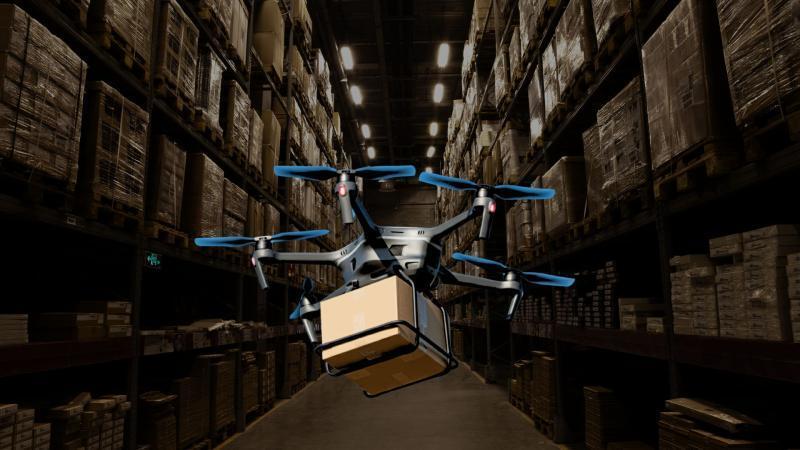
New Tech Optimizes Drone Fleets for Faster, Greener Deliveries
The world is on the cusp of a revolution in last-mile delivery, and it’s being driven by drones. These unmanned aerial vehicles (UAVs) have the potential to transform the way we receive our packages, making deliveries faster, more efficient, and environmentally friendly. However, there’s a crucial challenge that needs to be addressed before we can reap the full benefits of drone-delivered packages: the Drone Warehouse Problem.
The Drone Warehouse Problem refers to the logistical nightmare of managing a fleet of drones, each with its own unique characteristics, schedules, and delivery routes. It’s a complex puzzle that requires careful planning and optimization to ensure that packages are delivered quickly and efficiently. Recent research has made significant strides in tackling this problem, and the results are promising.
The Current State of Drone Delivery
Drone delivery is no longer a pipe dream. Companies like Amazon, UPS, and DHL are already testing drone delivery services in various parts of the world. The technology has come a long way since its inception, and drones are now capable of carrying payloads of up to 5 pounds (2.3 kilograms). However, despite the progress, there are still significant challenges to overcome.
One of the major hurdles is the logistics of managing a fleet of drones. Each drone has its own unique characteristics, such as its speed, range, and payload capacity. Additionally, drones require specific weather conditions to operate safely, and they need to be recharged and maintained regularly. All these factors make it difficult to optimize drone delivery schedules, leading to inefficiencies and delays.
The Research Breakthrough
A team of researchers from the Indian Institute of Technology (IIT) has made a significant breakthrough in addressing the Drone Warehouse Problem. They have developed a novel algorithm that optimizes drone delivery schedules, allowing warehouses to efficiently manage varied drone fleets.
The algorithm, known as the Drone Fleet Scheduling Algorithm (DFSA), takes into account various factors such as drone availability, weather conditions, and package priority. It uses a combination of machine learning and linear programming to optimize the delivery schedule, ensuring that packages are delivered quickly and efficiently.
How the Algorithm Works
The DFSA algorithm works by breaking down the delivery process into smaller, manageable tasks. It starts by identifying the available drones and their respective characteristics. The algorithm then uses machine learning to predict the weather conditions and optimize the delivery routes accordingly.
The next step is to prioritize the packages based on their urgency and importance. The algorithm assigns a priority score to each package, taking into account factors such as the customer’s location, the package’s weight, and the delivery deadline.
Finally, the algorithm uses linear programming to optimize the delivery schedule, ensuring that the drones are routed efficiently and that the packages are delivered on time.
The Benefits of Optimized Drone Fleets
The benefits of optimized drone fleets are numerous. For one, it allows warehouses to efficiently manage varied drone fleets, ensuring that packages are delivered quickly and reliably. Additionally, the algorithm can help reduce the environmental impact of drone delivery by optimizing the delivery routes and reducing the number of drones required.
The optimized delivery schedule also means that customers can expect faster delivery times, which is a major advantage in today’s fast-paced e-commerce landscape. According to a study by the International Air Transport Association (IATA), 71% of customers expect same-day or next-day delivery, and 40% expect real-time updates on their package’s location.
The Future of Drone Delivery
The development of the DFSA algorithm is a significant step towards making drone delivery a reality. With its ability to optimize drone delivery schedules, the algorithm has the potential to revolutionize the logistics industry and transform the way we receive our packages.
However, there are still challenges to overcome before drone delivery becomes mainstream. One of the major hurdles is the regulatory environment. Drone delivery is still a relatively new concept, and there are many regulatory hurdles that need to be overcome before it can become a widespread reality.
Another challenge is the public’s perception of drone delivery. Some people may be concerned about the safety and privacy implications of drones flying overhead. However, with the development of more advanced technologies, such as autonomous drones and advanced sensing systems, these concerns can be alleviated.
Conclusion
The development of the DFSA algorithm is a significant breakthrough in the field of drone delivery. With its ability to optimize drone delivery schedules, the algorithm has the potential to revolutionize the logistics industry and transform the way we receive our packages.
As the technology continues to evolve, we can expect to see more widespread adoption of drone delivery. With its ability to deliver packages quickly and efficiently, drone delivery has the potential to become a game-changer for the logistics industry.
Source:
https://researchmatters.in/news/novel-algorithm-tackles-drone-warehouse-problem-faster-deliveries






